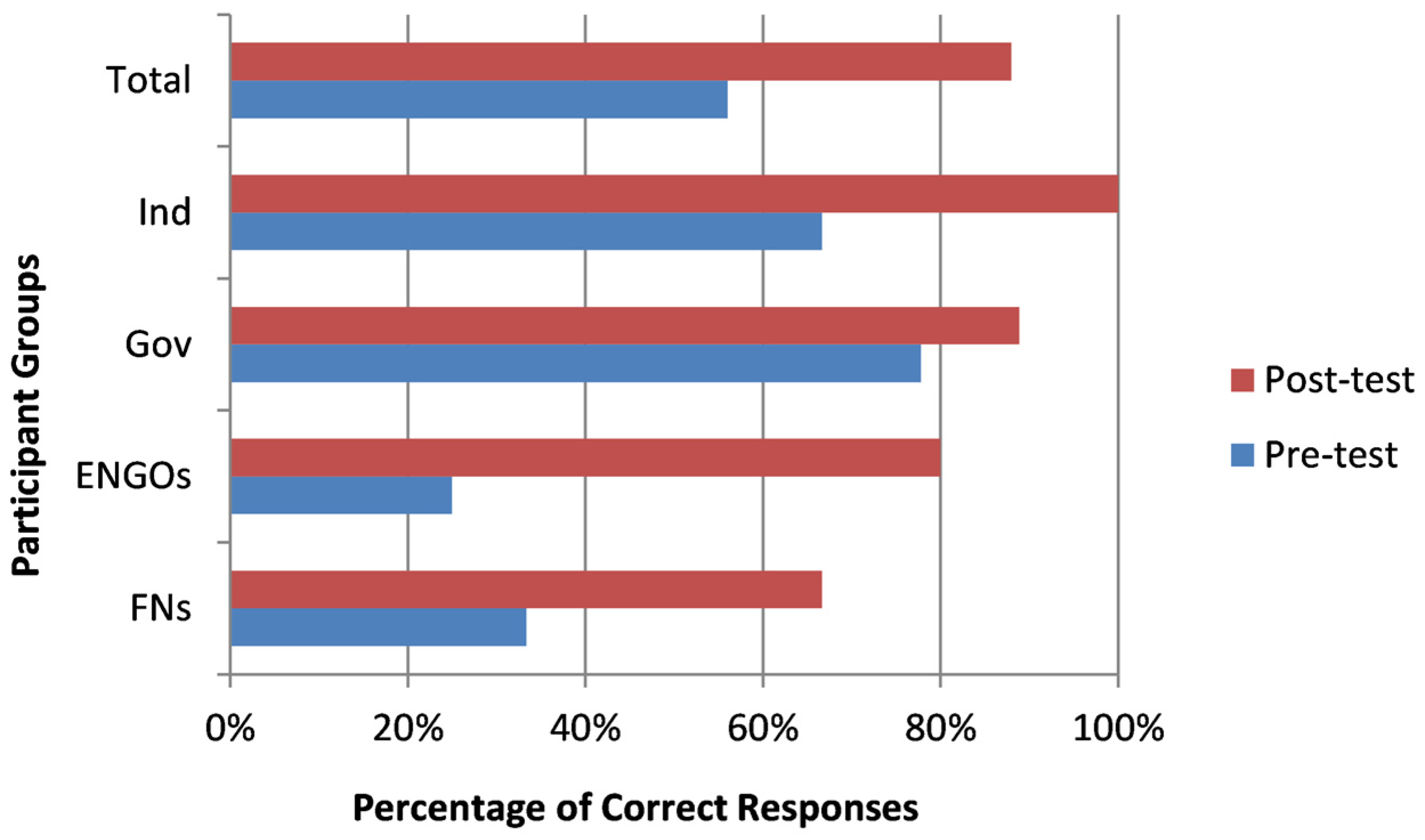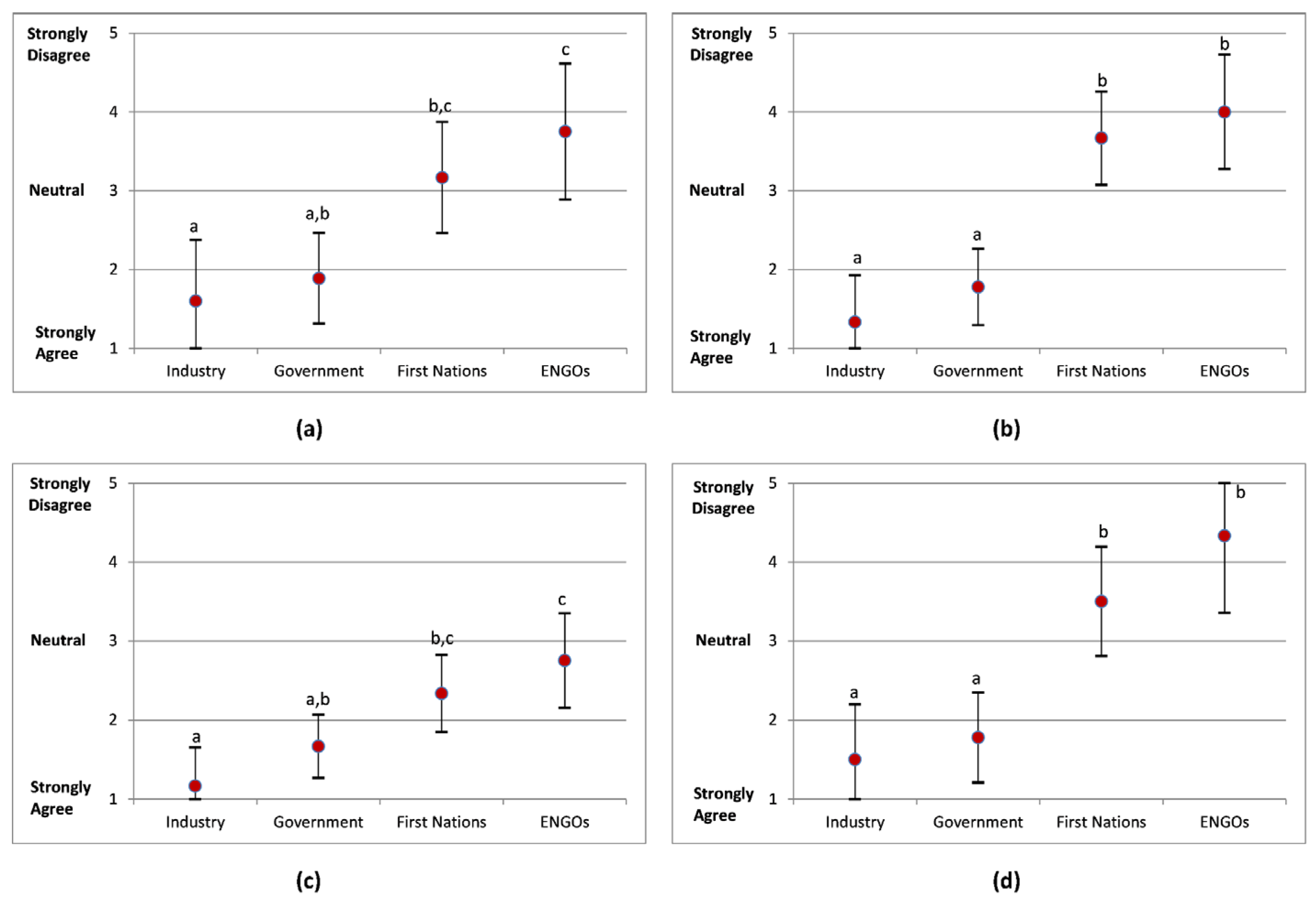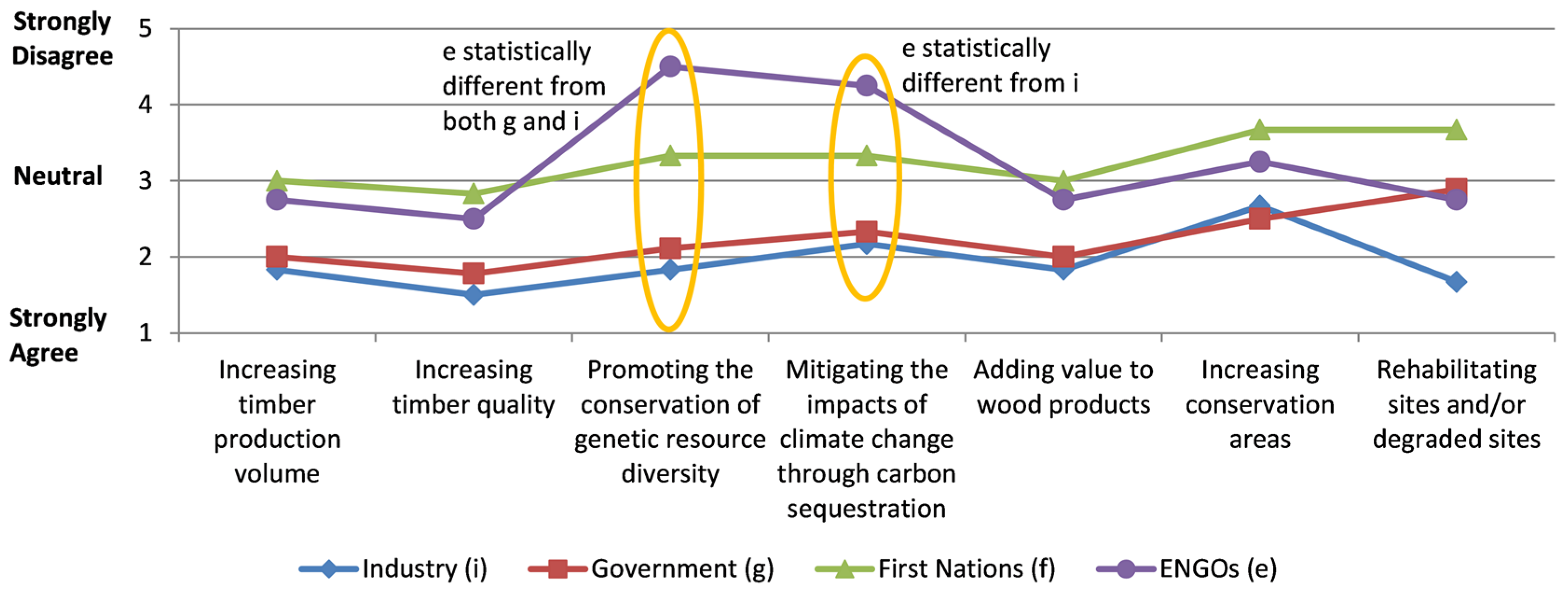4.2.1. Perceived Benefits of MAS
Qualitative analysis identified several perceived benefits of MAS. Among all groups, its ability to select for desired traits was the most frequently reported. In fact, 23 of the 25 participants (92%) specified this benefit at least once in their interview. Forest regeneration benefits and tree breeder benefits were two categories most commonly identified among participants. Within the forest regeneration benefits category, industry focused traits and improved forest resiliency were discussed often. In fact, 60% of participants articulated its potential ability to select for industry focused traits, 44% stated its potential ability to help in climate change adaptation, and 36% noted its potential use against pests and diseases. For climate change adaptation and pest/disease resistance, industry participants discussed these two benefits with the highest frequency.
Another benefit commonly identified by all groups was MAS’s time saving ability in the tree breeding process (identified by 19 of the 25 participants (76%)). Other notable benefits to the tree breeding process are that MAS would serve as an additional tool (44%), and increase the screening capacity (36%), for tree breeders. Government and industry emphasized that MAS would not replace field trials and provenance testing, but its ability to speed up the screening process, both in the selection stage and in future mitigation efforts, would be useful. One participant stated that he is producing trees today that may be planted 15 years from now, and then subsequently harvested 50 years after that. As such, having screening tools like MAS would help breeders combat new pests or diseases that are not an issue today, ensuring seedlings planted are resilient.
An interesting benefit discussed by a few participants was that MAS could relieve harvesting pressure from other stands. Here it was described that if this tool could be used to increase timber production in a given area (i.e., produce a greater amount of cubic metres of wood), and if met with a well-designed policy or moratorium, other areas could be conserved from harvest. This is because a company would theoretically be able to reach their maximum harvestable volume within a smaller area; hence other areas could be protected from harvest. Moreover, ENGOs argued further that industry desires a certain level of wood quality, so if this tool could achieve that level elsewhere, this may relieve pressure off of old-growth stands.
Approximately a quarter of the participants identified that MAS could be used to produce faster growing trees, which would improve the forest ecosystem. Regenerating a stand in a more timely fashion could be beneficial for wildlife habitat by reducing wildlife corridors.
4.2.2. Perceived Concerns for MAS
The qualitative interviews revealed concerns that were categorized as: unknown impacts, issues with the technology, and implementation concerns. Of all identified concerns, unknown impacts were the most frequent. Careful inspection of this category reveals that it could have been alternatively classified as environmental concerns. The three most frequently reported concerns within this set were: impacts to genetic diversity, increased susceptibility (or reduced resiliency), and impacts to ecosystems. Each of these is generally related to decreased diversity. However, according to Brumlop and Finckh, MAS can actually be used to broaden the genetic base of species, ensuring that diversity is maintained or improved [
3]. Several published articles discuss how MAS has the potential to increase genetic variation by more easily incorporating wild seeds into breeding programs, compared to traditional breeding [
5,
7,
18].
Interview queries showed that concerns subsequently categorized as ‘impacts to the ecosystem’ were largely discussed in the context of reduced species diversity across the landscape. This specifically included reduced ecological diversity and ecosystem degradation resulting from intensive forest management. Some participants expressed that unfavourable characteristics may play an unknown evolutionary role in the forest, and that by reducing their natural presence, we may be negatively impacting the long-term health of the whole ecosystem.
ENGOs and First Nations were further concerned that MAS would facilitate the application of monocultures or plantations following harvest. However, this concern cannot be argued exclusively to MAS and genomic tools, but rather to any harvested area that is subjected to intentional reforestation. Concerns of this nature can be (and have been) addressed by regulations set by the provincial government. Forest Planning and Practices Regulations under the Forest and Range Practices Act (FRPA) outline stocking standards under Section 26. This regulation requires that stands be restocked “with ecologically suitable species that address immediate and long-term forest health issues on the area” [
19]. Former Chief Forester Jim Snetsinger elaborated in the 2009 memorandum on Guidance on Tree Species Composition at the Stand and Landscape Level that developed stocking standards should be mindful of existing species diversity, species vulnerability due to climate change, potential risks of insects and diseases, and maintenance of natural diversity at the forest level [
20]. Nonetheless, future implementation regulations designed to address the scope and usage of MAS should include species diversity requirements to acknowledge these concerns.
Perhaps unsurprisingly, ENGOs and First Nations participants identified environmental concerns with notable frequency. Environmental organizations are typically in the business of identifying and voicing potential negative impacts to ecosystems, individual species, and/or the environment, and First Nations cultural values and traditional practices are strongly connected to the forest. First Nation communities in BC are continually fighting land-use plans with government and industry in an effort to ensure a healthy forest ecosystem is maintained for social, environmental, and economic benefits.
Government participants expressed the strongest economic concerns. Although First Nations and industry recognized the expense in using this tool, no other group discussed the expense of developing such a tool. This monetary cost involved in using MAS was described in terms of the price to acquire and apply this technology, to undergo training on how to perform and interpret trials, and to invest in a facility to perform these tests. Government has already invested a substantial amount of money and resources into the research and development of MAS. It is thus not surprising that government participants spoke of their eagerness to see if the final deliverables will meet the proposed expectations and if the advantages come into fruition. This concern has likewise been addressed in the literature, stating that MAS will not be applied unless genetic gains can offset the cost of using the technology [
8,
13]. Eucalyptus simulation studies have already shown that the breeding cycle could be halved when early-selection methods are employed [
12]. Additionally, the economic rotation age in genetically improved white spruce can be reduced by up to nine years [
13]. Porth et al. recognized that the cost of producing seedlings is higher when genotyping is employed, however, this will be offset by increased volume, reduced timeframe, and the production of higher value products [
1]. Nonetheless, to date little of the genomics budget has been spent towards economic analysis [
1]. This concern should be addressed in future forest genomic research in Canada.
Government, industry, and First Nations participants also emphasized their concerns on public and First Nations perceptions towards MAS. Perception concerns were strictly focused on mistaking MAS for GE. This concern is supported by various studies done over the last 15 years that have assessed public perception towards GE and genetically modified organisms (GMOs), and the lack of public distinction from genomics. In studies done in the US and the European Union (EU), it was found that the public was generally uninformed about GE and genomic tools, and their current applications [
21,
22,
23,
24,
25]. It was frequently reported that negative perceptions towards biotechnology are not based on objective knowledge but rather shaped by protest groups and media, or from distrust with big business companies in the US (namely Monsanto), and regulatory agencies in the EU [
24,
25,
26]. Despite these views, the limited knowledge held by the public regarding biotechnology means that a flow of new and factual information can erode previous opinions over time [
25]. Indeed, in a study by Heuvel et al. respondents that initially associated genomics more closely to GE than conventional breeding changed their views following explanations of each type of biotechnology, ultimately ranking genomics more closely to conventional breeding and deeming it incomparable with GE [
22]. These two studies suggest that public awareness on biotechnology (and forest genomic tools more specifically) could and should be improved to mitigate this concern.
Another challenge identified by all participant groups is predicting what characteristics will be desired in trees 30, 50, or 80 years from now. Several participants mentioned that it is difficult to predict how future pests, diseases, and climates will impact forests. One argued that MAS does not provide any reassurance that a population adapted to today’s climate will be well adapted 60 years from now. Government participants also addressed the uncertainty of future markets and the difficulty in planning for the forest sector’s future needs.
Although predicting and selecting for the ‘right’ traits is difficult (if not impossible), it is not a limitation of MAS. Rather it is a limitation of breeding strategies in general—especially in trees, which inherently develop and evolve over long time periods.
Lastly, some participants voiced the need for a well-defined policy to accompany the introduction of this tool to ensure responsible usage. Government, ENGO, and industry participants all recommended that percentage limitations should be set for the proportion of a stand that employs this type of seed selection. Currently, there are standards set by the Chief Forester for seed use in the province. These standards regulate where orchard seeds and wild seeds can be planted and how diverse the parents need to be. There are no existing policies or regulations that specifically address the use of genetic markers within public forests. Hence, although MAS is not prohibited from being used within the province, there are also no policies that guide or define its use. This differs from other types of biotechnology, such as genetic modification. Under provincial policy (Section 5.1.8e of the Chief Forester’s Standards for Seed Use), the commercial use of genetically modified trees on public land is prohibited [
27]. Since MAS is a diagnostic tool that is meant to assist tree breeders in the selection process, and does not involve any modification at the genetic level of an individual, its use is currently not restricted by provincial policy or regulation. Updating policies and/or regulations to define how MAS should be applied would promote its responsible usage.
4.2.3. Perceived Usefulness of MAS
All participant groups reportedly agreed that MAS could be useful in the context of increasing timber production volume, increasing timber quality, and adding value to wood products. It is not surprising that positive responses were received for these uses as the interviews revealed that 60% of all participants identified that MAS could be beneficial in the selection of industry-focused traits. Similarly, all participant groups shared a neutral stance towards the potential role of MAS in the context of increasing conservation areas and rehabilitating sites and/or degraded sites. These findings are consistent with the identified benefits, as less than a quarter of participants discussed its use in selecting traits that would improve the forest ecosystem, and only 12% of all participants made reference to its use in relieving pressure off other stands.
ENGOs held a significantly different position than government and industry in the context of promoting the conservation of genetic resource diversity. While ENGOs disagreed with this statement, government and industry agreed that MAS could be useful in this context. Again, this is likely because ENGOs are unfamiliar with the technical details of tree breeding and are unaware that MAS is not expected to reduce the genetic diversity any further than traditional breeding practices [
3].
Lastly, industry and ENGOs demonstrated significantly different opinions regarding the usefulness of MAS in mitigating the impacts of climate change through carbon sequestration. While industry agreed with this statement, ENGOs disagreed. As with the previous scenarios, these results are consistent with the analysis of reported benefits. In fact, 66.7% of industry participants had identified that MAS could be used in climate change adaptation, compared to only 25% of ENGO participants.











